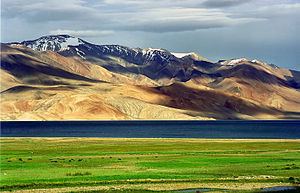Habitat loss 1.4065% Area 143,300 km² Mammal species 45 | Protected 18.28% Bird species 172 | |
 | ||
Biome Montane grasslands and shrublands Borders Pamir alpine desert and tundra
North Tibetan Plateau-Kunlun Mountains and alpine desert
Central Tibetan Plateau alpine steppe
Western Himalayan alpine shrub and meadows
Northwestern Himalayan alpine shrub and meadows
Paropamisus xeric woodlands Countries India, China, Afghanistan and Pakistan | ||
The Karakoram-West Tibetan Plateau alpine steppe is a montane grasslands and shrublands ecoregion found in parts of Pakistan, China, Afghanistan, and India.
Contents
Setting
The Karakoram-West Tibetan Plateau alpine steppe is an area of high-elevation grasslands covering 143,300 square kilometres (55,300 sq mi). It is centered on the Karakoram Range, west of the Himalaya Range. It also includes nearby ranges, such as the Ladakh Range.
Climate
The mean annual precipitation in the ecoregion varies from 200 to 900 millimetres (7.9 to 35.4 in), 90 percent in the form of snow.
Flora
Most of this ecoregion consists of grasslands and herbaceous plants. Protected slopes and ravines contains Salix denticulata, Mertensia tibetica, Potentilla desertorum, Juniperus polycarpus, Polygonum viviparum, Berberis pachyacantha, Rosa webbiana, and Spiraea lycoides. Where vegetation ceases to grow, around 4,500 metres (14,800 ft), are found Delphinium cashmerianum, Glechoma tibetica, Silene longicarpophora, Potentilla fruticosa, and Nepeta spp.
Shrublands and woodlands are found in valley bottoms. These include Hippophae rhamnoides, Myricaria elegans, Salix viminalis, Capparis spinosa, Tribulus terrestris, Pegamum harmala, Sophora alopecuroides, and Lycium ruthenicum. A few remnant steppe forests of Juniperus macropoda and Juniperus indica are still found here.
Fauna
Sheep in this ecoregion include the Marco Polo sheep, Tibetan argali, and urial. Goats include the markhor and ibex.
The sheep and goats, as well as smaller mammals, make this ecoregion excellent habitat for the snow leopard.
Both the brown bear and Himalayan black bear are found here.
Bird species richness is low. Common birds include Guldenstadt's redstart, Himalayan monal, rosefinches, raptors, and vultures.
Conservation
Much of the montane habitat in this ecoregion lies in protected areas. These include
